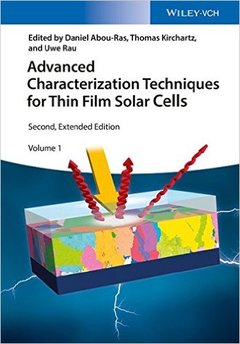Description
Advanced Characterization Techniques for Thin Film Solar Cells (2nd Ed.)
Coordinators: Abou-Ras Daniel, Kirchartz Thomas, Rau Uwe
Language: English
Subject for Advanced Characterization Techniques for Thin Film Solar...:
Keywords
spectroscopy
760 p. · 17.5x25.2 cm · Hardback
Description
/li>Contents
/li>Biography
/li>
Building on a proven concept, this new edition also covers thermography, transient optoelectronic methods, and absorption and photocurrent spectroscopy.
INTRODUCTION TO THIN-FILM PHOTOVOLTAICS
Introduction
The Photovoltaic Principle
Functional Layers in Thin-Film Solar Cells
Comjparison of Various Thin-Film Solar-Cell Types
Conclusions
PART II. Device Characterization
FUNDAMENTAL ELECTRICAL CHARACTERIZATIONS OF THIN-FILM SOLAR CELLS
Introduction
Current/Voltage Curves
Quantum-Efficiency Measurements
ELECTROLUMINESCENCE ANALYSIS OF SOLAR CELLS AND SOLAR MODULES
Introduction
Basics
Spectrally Resolved EL
Spatially Resolved EL of c-Si Solar Cells
EL Imaging of Thin-Film Solar Cells and Modules
Electromodulated Luminescence under Illumination
CAPACITANCE SPECTROSCOPY OF THIN-FILM SOLAR CELLS
Introduction
Admittance Basics
Sample Requirements
Instrumentation
CV Profiling and the Depletion Approximation
Admittance Response of Deep States
The Influence of Deep States on CV Profiles
Deep-Level Transient Spectroscopy
Admittance Spectroscopy
Drive-Level Capacitance Profiling
Photocapacitance
The Meyer-Neldel Rule
Spatial Inhomogeneities and Interface States
Metastability
TIME-OF-FLIGHT ANALYSIS
Introduction
Fundamentals of TOF Measurements
Experimental Details
Analysis of TOF Results
TRANSIENT OPTOELECTRONIC CHARACTERIZATION OF THIN-FILM SOLAR CELLS
Introduction
Measurement Setup
Charge Extraction and Transient Photovoltage
CE with Linearly Increased Voltage
Time-Delayed Collection Field Method
STEADY-STATE PHOTOCARRIER GRATING METHOD
Introduction
Basic Analysis of SSPG and Photocurrent Response
Experimental Setup
Data Analysis
Results
DOS Determination
Data Collection by Automization and Combination with other Experiments
Summary
PART III. Materials Characterization
ABSORPTION AND PHOTOCURRENT SPECTROSCOPY WITH HIGH DYNAMIC RANGE
Introduction
Photothermal Deflection Spectroscopy
Fourier Transform Photocurrent Spectroscopy
SPECTROSCOPIC ELLIPSOMETRY
Introduction
Theory
Ellipsometry Instrumentation
Data Analysis
Spectroscopic Ellipsometry forThin-Film Photovoltaics
Summary and Outlook
CHARACTERIZING THE LIGHT-TRAPPING PROPERTIES OF TEXTURED SURFACES WITH SCANNING NEAR-FIELD OPTICAL MICROSCOPY
Introduction
How Does a Scanning Near-Field Optical Microscope Work?
The Role of Evanescent Modes for Light Trapping
Analysis of Scanning Near-Field Optical Microscopy Images by Fast Fourier Transformation
Investigation of Individua lWaveguide Modes
Light Propagation inThin-Film Solar Cells Investigated with Dual-Probe SNOM
Conclusion
PHOTOLUMINESCENCE ANALYSIS OF THIN-FILM SOLAR CELLS
Introduction
Experimental Issues
Basic Transitions
Case Studies
ELECTRON-SPIN RESONANCE (ESR) IN HYDROGENATED AMORPHOUS SILICON (a-Si:H)
Introduction
Basics of ESR
How to Measure ESR
The g Tensor and Hyperfine Interaction in Disordered Solids
Discussion of Selected Results
Alternative ESR Detection
Concluding Remarks
SCANNING PROBE MICROSCOPY ON INORGANIC THIN FILMS FOR SOLAR CELLS
Introduction
Experimental Background
Selected Applications
Summary
ELECTRON MICROSCOPY ON THIN FILMS FOR SOLAR CELLS
Introduction
Scanning Electron Microscopy
Transmission Electron Microscopy
Sample Preparation Techniques
X-RAY AND NEUTRON DIFFRACTION ON MATERIALS FOR THIN-FILM SOLAR CELLS
Introduction
Diffraction of X-Rays and Neutron by Matter
Grazing Incidence X-Ray Diffraction (GIXRD)
Neutron Diffraction of Absorber Materials for Thin-Film Solar Cells
Anomalous Scattering of Synchrotron X-Rays
IN SITU REAL-TIME CHARACTERIZATION OF THIN-FILM GROWTH
Introduction
Real-Time In Situ Characterization Techniques for Thin-Film Growth
X-Ray Methods for Real-Time Growth Analysis
Light Scattering and Reflection
Summary
RAMAN-SPECTROSCOPY ON THIN FILMS FOR SOLAR CELLS
Introduction
Fundamentals of Raman Spectroscopy
Vibrational Modes in Crystalline Materials
Experimental Considerations
Characterization of Thin-Film Photovoltaic Materials
Conclusions
SOFT X-RAY AND ELECTRON SPECTROSCOPY: A UNIQUE "TOOL CHEST" TO CHARACTERIZE THE CHEMICAL AND ELECTRONIC PROPERTIES OF SURFACES AND INTERFACES
Introduction
Charact
Daniel Abou-Ras is senior scientist at the Helmholtz Center Berlin for Materials and Energy, Germany. He obtained his PhD at ETH Zurich, Switzerland. In 2005, he was awarded the MRS Graduate Student Gold Award at the MRS Spring Meeting. His research interests are correlative approaches in scanning as well as transmission electron microscopy, mainly applied on semiconductor devices.
Thomas Kirchartz is professor in the Department of Electrical Engineering and Information Technology at the University Duisburg-Essen and head of the Division for Organic and Hybrid Solar Cells at the Institute of Energy and Climate Research 5 - Photovoltaics at the Research Center Julich, Germany. Previously he was Junior Research Fellow in the Department of Physics at Imperial College London, UK. He obtained his degree in Electrical Engineering and Information Technology from the University of Stuttgart, Germany, in 2006 and his PhD from the RWTH Aachen, Germany, in 2009.
Uwe Rau is full professor at the Faculty Electrical Engineering and Computer Science of the RWTH Aachen, Germany, since 2007 and head of the Institute of Energy and Climate Research 5 - Photovoltaics at the Research Center Julich, Germany. He obtained his PhD 1991 from the University Tubingen and was scientific group leader from 1995-2007 at the Universities of Bayreuth and Stuttgart.
These books may interest you

Advances in Thin-Film Solar Cells 143.25 €



